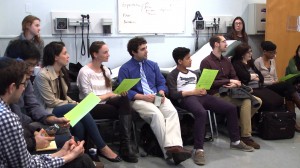Editors’ Note: This blog post is part of a series of posts on a new longitudinal-theme medical education program at Albert Einstein College of Medicine: the Population Health and the Practice of Medicine (PHPM) curriculum. A faculty working group developed a map distinguishing where PHPM topics were already covered in our current curriculum. In other cases, the group worked with faculty to integrate PHPM content into existing basic and clinical science instructional sessions. Wherever educational gaps were identified, instructors developed new sessions. One session, involving the entire Einstein second-year class, focuses on patient safety and quality improvement.
By Michael L. Rinke, M.D., Ph.D.
It’s a stark reality. According to the Journal of Patient Safety, between 200,000 and 400,000 patients die each year because of medical errors. This makes such errors the third leading cause of death in the United States, behind only heart disease and cancer. In effect, the healthcare system is contributing to the death of the equivalent of every passenger on one or two completely full 747 airplanes every day and yet millions of people continue to “fly” with us, and come to us for medical care. Our first charge as physicians is “do no harm,” and yet we clearly are not living up to this most basic mission.
Why Is the Practice of Quality Improvement Essential?
In order to fix this inexcusable but complex problem, we must more stringently employ the principles of patient safety and quality improvement. The Department of Health and Human Services defines quality improvement as “systematic and continuous actions that lead to measurable improvement in healthcare services and the health status of populations.”
According to the Health Resources and Services Administration, the four key principles of quality improvement are:
- work on systems and processes,
- focus on patients,
- focus on being part of the team, and
- focus on the use of data.
It is critical that medical students learn at the earliest stages of their training the basic models and tools of quality improvement, the challenges and opportunities of delivering consistently high-quality care and the ways to prevent medical errors and disclose them to patients when they happen. By gaining this knowledge, our future doctors will know not only how to get and keep patients healthy, but how to increase the likelihood of providing excellent, safe care to every patient.
Quality improvement and patient safety knowledge is tested on the United States Medical Licensing Examination 1, 2CK, and 3 exams and almost all medical board licensing tests. The Accreditation Council for Graduate Medical Education requires medical learners to know about and take part in quality-improvement and patient-safety activities.
How Our Curriculum Teaches Quality Improvement and Patient Safety to Einstein Medical Students
 As part of the broader effort to improve our coverage of topics in population health and the practice of medicine (PHPM) at Albert Einstein College of Medicine, the Quality Improvement and Patient Safety group has been working hard to integrate these topics across all four years of the medical school program. Over the past 18 months, we have highlighted and integrated ongoing quality-improvement and patient-safety opportunities in the PHPM curriculum in such areas as the Patients, Doctors and Communities course; a class in the bioethics course called Medical Errors & Patient Safety; and the obstetrics and gynecology clerkship.
As part of the broader effort to improve our coverage of topics in population health and the practice of medicine (PHPM) at Albert Einstein College of Medicine, the Quality Improvement and Patient Safety group has been working hard to integrate these topics across all four years of the medical school program. Over the past 18 months, we have highlighted and integrated ongoing quality-improvement and patient-safety opportunities in the PHPM curriculum in such areas as the Patients, Doctors and Communities course; a class in the bioethics course called Medical Errors & Patient Safety; and the obstetrics and gynecology clerkship.
Additionally, a group of Montefiore Health System physicians, administrators, pharmacists and infection-prevention specialists created new patient-safety and quality-improvement opportunities in each of the four medical school years.
- Quality Improvement 101 mini-session for first-year students
- Patient-safety hands-on session for second-year students
- Medical-error disclosure, interdisciplinary role-play experience and learning about second-victim effects for third-year students in the pediatrics clerkship
- Policy implications of quality improvement for fourth-year students in the ambulatory medicine clerkship.
This collaboration between Montefiore and Einstein has brought educators with extensive real-world quality-improvement and patient-safety experience to the medical school classroom via adult-learning, hands-on teaching strategies.
Where Quality Improvement and Patient Safety Go from Here
As medicine races into the 21st century with technological, biological and medication advances emerging almost daily, it is imperative that all doctors and medical students see quality improvement and patient safety as central to their jobs as physicians and future physicians. Einstein students will be well positioned to be in the vanguard of physicians steeped in quality improvement and patient safety, with the goal of bringing safe and effective care to every patient, every time. They will be among those who can stay true to the core of the physician’s creed: “First, do no harm.”


Comments on this entry are closed.
These are some great points. Medical errors can be life ending and have far reaching impacts for the patient, their family, and the medical staff as well. Thank you!
I was a part of the mini-session offered to first-years – it was easily one of my favorite experiences of first year. Considering the impact of quality improvement, I’m glad to see the initiative spread to my upcoming years in medical school. I look forward to the expansion of such educational topics both at Einstein as well as other medical schools around the country.